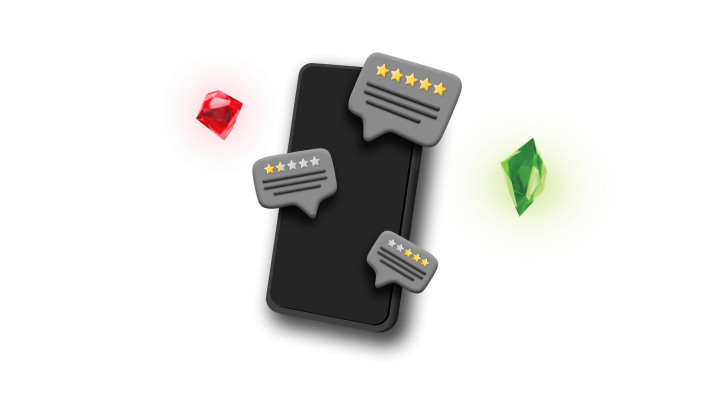Personalized Marketing – Definition & Examples

This post was originally published in February 2022 and updated in November 2023.
Consumers can be a tough crowd to please. If you’ve ever worked within the world of B2C, you’re probably all too familiar with this. Consumers decide within seconds if they’re interested in your product or service, so you’ve got to hit them with everything you’ve got (without overwhelming them, of course).
Personalized marketing is one particularly important tool in your arsenal. Its aim is to increase engagement, better communication, and strengthen the relationship between businesses and their customers or potential customers. In short, it makes consumers feel like you’re communicating directly with them.
Take marketing out of the equation. People like to be made to feel special, right? Now put marketing back into the mix, and ask yourself why it would be any different. Truthfully, it’s not. Potential customers are far more likely to become paying customers if they feel special and are treated as an individual when they come into contact with your brand. This is precisely why personalized marketing is crucial for driving conversions and ROI.
How can we help?
For more questions, or to speak to award-winning marketers here at Moburst, get in touch.
What is Personalized Marketing?
Personalized marketing is a type of data-driven marketing strategy that marketers and businesses use to deliver individualized marketing messages and content to potential or current customers. It combines data collection, analysis, and automation technology.
Tailoring your marketing strategy to each customer can take many different forms. It could be as simple as sending a new customer or subscriber a welcome email, sending a cart abandonment email, using the customer’s name wherever appropriate, or creating an edit of products you think they may like based on their previous activity on your website. It’s all about understanding what your users are all about, how they may find value in your product or service, and tailoring your strategy accordingly.

The Benefits of Personalized Marketing
It’s no surprise to hear that there are many benefits of personalized marketing. It’s one of the most popular digital marketing services and is utilized by the world’s most successful companies for a reason. Let us break down the main benefits for you here…
Customer Experience
There’s no doubt that taking a personalized approach to marketing to consumers provides a better customer experience. Naturally, the better the experience consumers have when interacting with your brand, the more likely they are to convert and remain loyal.
Beyond this, a better customer experience incentivizes customers to provide more personal info (e.g. by filling in forms and surveys to get discounts and downloading whitepapers etc.) since they know they’re getting something in return.
These days, consumers expect brands to deliver a more tailored experience when they come back to the site, based on the data that they’ve provided. It goes without saying that their data must be guarded safely and comply with local and international regulations.

Brand Loyalty
As a result of the above, customers are more likely to return knowing that they’re going to have a positive, individualized experience. This increased brand loyalty should not go underestimated: it can be the difference between consumers choosing your business over another in the future.
Revenue/ ROI
Investing efforts and finances into the appropriate channels and methods of communication for consumers means less wasted money and higher profits. Not only are potential customers more likely to convert into paying ones, and return in the future, thus increasing profits, but you’re probably spending less to acquire them in the first place. Less money is going towards reaching out to consumers in a less personalized, less effective way.
Automation technology allows marketers to establish which channels and communication methods are relevant to which customers by highlighting data points such as engagement rates etc.
Omnichannel Consistency
Brands are present on many different channels, from social media to apps, websites, and emails. Customers have so many different ways to interact with them. This is why it’s imperative to be consistent across these diverse channels and allow the personalized approach to run seamlessly through them all.
How can we help?
For more questions, or to speak to award-winning marketers here at Moburst, get in touch.
Personalized Marketing Campaign Types
We’ve explored what personalized marketing is and what its benefits are, so you know why you should be implementing it into your broader marketing strategy. However, now it’s time to cover the different ways personalized marketing can appear and be used within.
Social Media Marketing
You can increase brand loyalty and awareness by interacting with consumers on social media. Put your brand at the forefront of people’s minds this way. Use automation tools to deliver personalized and valuable content and messages to consumers, which in turn will enable the collection of data that will help improve future communication. This cycle will eventually increase conversions.
Email Marketing
Email campaigns can be bettered by personalized marketing. Emails can be individualized and sent to segmented groups within a larger subscriber list based on anything from interests to age. In order to do this, you need to truly understand your audience so that you can ensure the content you’re sending their way is highly relevant.
An example of how to do this is by getting users to fill out a form upon signing up for an email newsletter so that you can gather data about their interests, date of birth, location, etc.
Both cart abandonment emails and welcome emails that we mentioned earlier are examples of email marketing campaigns.
FOMO
This might take you by surprise, but the “fear of missing out” factor is a big tool marketers can, and often do, use at their disposal. Nobody likes the feeling of missing out, so consumers are actively trying to avoid it. In this case, marketers can try and play on this fear by elevating the feeling that someone may be missing out by not using their product or service.
Examples of how to do this include indicating how many other people are currently looking at a product, how fast it’s selling, how many of a specific product are left in stock, a countdown that shows how long until a sale starts/ ends, a free gift with purchase and so much more.
Personalized Marketing Strategy Guide
The key to an effective personalized marketing campaign lies in the steps you take to get there, whether that’s the point at which you begin (e.g. a competitive analysis) or the tests you run once you’ve put all of your tools in place.
1. Competitive Analysis
See what your competitors are doing in the realm of personalized marketing. Looking at their approach will help inform you of what resonates with your target audience, what to avoid, how to make yourself stand out, and more. It’s always important to keep your eye on competitors to understand how to position yourself and keep ahead of the game. Here’s more information on conducting an effective competitive analysis.
2. Select Tools
Content personalization engines exist for a reason, so take advantage. There are countless CRM software out there, find the one that suits your business based on its strengths and how they match up to your KPIs. The same goes for data management and data analytics platforms.

3. Collect Data
Gather all of the data that you can on the number of clicks, time spent on site, consumer purchase history, abandoned shopping carts, etc. The tools you selected at the above stage will help you to do this.
4. Data Analysis
It’s all well and good collecting data, but it’s worthless unless you analyze it to be able to best utilize it in your strategy. You should adjust your strategy according to what the data shows to provide the most relevant, personalized content to consumers. Again, the tools you select will help you achieve this.
5. A/B Tests
A/B tests provide a clear indication of what works with different types of consumers and what doesn’t, which is precisely what you need for an effective personalized marketing strategy. A/B tests help validate the performance of your current method (or highlight what you should be doing instead).
How can we help?
For more questions, or to speak to award-winning marketers here at Moburst, get in touch.
Personalized Marketing Tools
We’ve covered the benefits of personalized marketing, different campaign types, top tips for building a personalized marketing strategy, and more. Here’s a breakdown of the various tools you should consider using to aid you in your process.
CRM Software
CRM is the process where businesses administer their interactions with customers and potential customers, most commonly by using data analysis to examine large quantities of information.
Customer Relationship Management (CRM) software uses technology to manage these interactions in order to build customer relationships, optimize processes, boost sales, improve customer service and customer experiences, and ultimately increase revenue/ ROI. Any data you can possibly learn about potential customers, including their names, email addresses, and purchase history, can be stored on your CRM.
Data Management Platform
In order to be successful with personalized marketing, collecting data is essential. Therefore, you need a tool that will help gather this data, right? Data management platforms do exactly this from a range of sources. They then share the relevant audience data with businesses or media buyers.
Data Analytics Platform
Once you’ve gathered the data, you need to understand how to use it and what it means. As such, you need a data analytics platform to analyze the data behaviorally.
FAQs
There are many benefits of personalized marketing, including improved customer experience, brand loyalty, omnichannel consistency and increased conversions and ROI.
Personalized marketing is important because customers care about their experiences across websites, apps, newsletters, social media, etc. more and more. They expect to be treated as individuals with specific interests, which means businesses must cater towards this. By offering customers and potential customers the information they want, or that will appeal to them without them even being conscious of it, and doing so in the right places, you’re far more likely to meet your KPIs. Potential customers are more likely to become paying customers when they experience a personalized marketing campaign.
When you log into your Amazon account, what’s the first thing you see? It’s likely a curated edit of product recommendations tailored to your browse and purchase history on the site. This might suit you, as it gives you instant access to products you may need or want, and it certainly suits Amazon to draw you in by any means possible and encourage more purchases. Another famous example are Spotify’s Discover Weekly and Year in Review playlists. The first is a playlist curated of new music the algorithm predicts you may like based on your listening preferences, and the latter is a playlist of the music you have listened to most over the past year.






